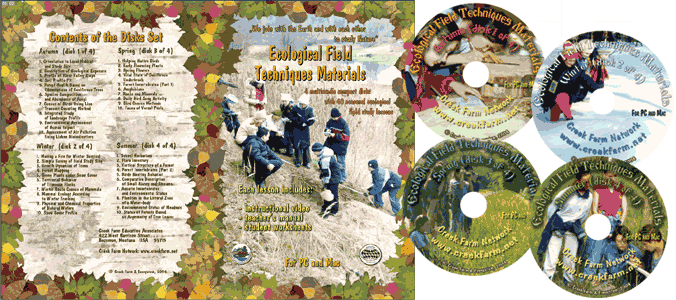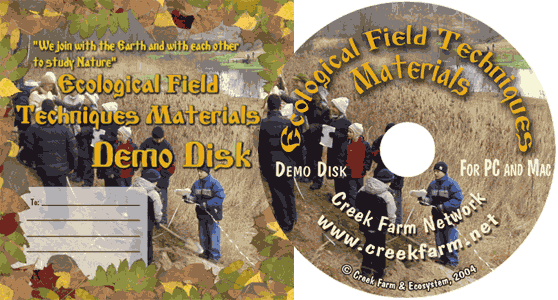|
| Our Field Ecology Center published more than
180 methodical materials for nature studies. Some of them are in English: |
|
|
|
Phenology of Plant Florescence
© Alexsander S. Bogolyubov,
Russia, 2002
© Michael J. Brody, USA,
2003
 This manual describes
the study of spatial dynamics of species composition of flowering plants in different
biotopes. The main phases of the work are: planning the survey, finding flowering plants,
determination of the phenological phase of florescence, listing and analyzing biotopic
differences in species composition and time of florescence. This manual describes
the study of spatial dynamics of species composition of flowering plants in different
biotopes. The main phases of the work are: planning the survey, finding flowering plants,
determination of the phenological phase of florescence, listing and analyzing biotopic
differences in species composition and time of florescence.
This field study has instructional video
featuring real students conducting the ecological field techniques in nature. Each video
illustrates the primary instructional outcomes and the major steps in accomplishing the
task including reporting the results.
Introduction
It is well known that angiosperm plants growing in the temperate
climatic zone do not blossom all year round but during a rather short period of
time. The time and duration of plant florescence is individual and depend on
many factors.
The main factor that determines the beginning of plant florescence is the temperature
at the plant's location. These conditions differ considerably even within the
boundaries of one climatic microregion. Temperature greatly varies in biotopes
Ц depending on the presence, density and height of the forest canopy. Trees have
an influence upon the thickness of snow cover in winter, the rate of snowmelt and the
warming of soil. Mesorelief works similarly.
Besides external factors, biological properties and adaptations of plants also
have influence upon the time and duration of plant florescence.
First, time and duration of florescence depend on the life form of a plant.
According to the classification of life forms proposed by Danish scientist-botanist K.
Raunikier, all plants differ in the location of regeneration buds from which the plant's
organs (shoots, leaves and flowers) develop. The location of regeneration buds
characterizes a plant's adaptation to life during the unfavorable seasons of the year. An
unfavorable season in the tropics is drought, whereas in our country it is winter.
All plants are divided into five life forms depending on the location of buds
against the ground or snow cover.
1. Phanerophyte (from the Greek word УphanerosФ Ц open, evident).
The buds on plants of this type winter Уopenly,Ф quite high above the ground. That is
why special bud scales usually protect them. All our trees and shrubs belong
to phanerophytes.
2. Geophytes (from Greek word УgeosФ Ц land). As it is seen from
the name, regeneration buds of these plants are located underground. Their aboveground
part completely dies off in winter. New shoots develop in the spring, from buds that are
located on tubers, bulbs or rhizomes, which spend the winter under
protection of the soil layer. Geophytes include many perennial herbaceous plants, such as
the well-known gladiolus, tulip (bulbous geophytes) and potato (tuber
geophyte).
3. Hemicryptophytes (from the Greek words УhemiФ Ц semi- and
УcryptosФ Ц hidden). These are herbaceous plants that have
regeneration buds located at the soil surface level, often under the protection of a
debris layer consisting of fallen leaves and other vegetation debris. The mentioned
protection is one more additional УcoverФ for the buds. Dandelion (its
regeneration buds are located on a rosette near the ground) and yellow-cup
(regeneration buds are located on creeping sprouts which are found on the ground) belong
to hemicryptophytes.
4. Gamaephytes. Regeneration buds of such plants are located not
higher than 20-30cm above the ground, and they spend the winter under the protection of
snow cover (red whortleberries, bilberry).
5. Terophytes. These are plants that die off completely by winter and
only their seed winters (they all are annual plants).
Different plants blossom in different time periods depending on their life forms. The
deeper the buds are hidden, the later the plants blossom and the more nutrients are stored
up by the plant in autumn and the longer the florescence period lasts.
The second factor that influences the time and duration of plant blossoming is the
method of pollination. All plants are divided into two main groups according to this
feature: wind-pollinated and insect-pollinated.
Wind-pollinated plants do not have to wait until warm weather comes and insects appear.
It is the other way round: many wind-pollinated plants blossom very early, before leaves
appear in the tree crown, as they make for worse wind conditions in ...
This was only the first page from the manual and its full version you can see in the
Ecological Field Studies Techniques Video 4CD Set:
It is possible to purchase the complete set of 40 seasonal Ecological Field
Studies Techniques Video (in mpg format) in an attractive 4 compact disk set.
These compact disks are compatible with Mac and PC computers.
The videos are suitable for individual student or whole class instruction. To purchase the complete 4CD set
write to ecosystema1994@yandex.ru in a free form.

Ecological Field Studies Demo Disk:
We also have a free and interesting demonstration disk that explains our ecological field studies approach.
The demo disk has short excerpts from all the seasonal field study videos as well as sample text from all the teacher manuals.
The disk has an entertaining automatic walk through which describes the field study approach and explains how field studies meet education standards.
You can also download the Demo Disc from ecosystema.ru/eng/eftm/CD_Demo.iso.
This is a virtual hybrid (for PC and Mac computers) CD-ROM image (one 563 Mb file "CD_Demo.iso").
You can write this image to the CD and use it in your computer in ordinary way.
You also can use emulator software of virtual CD-ROM drive to play the disk directly from your hard disk.

|







